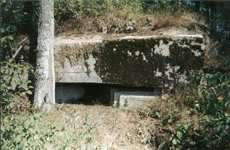 In May of 1935, Hitler refused all of resolutions of Paris Conference of 1926 (part of Versailles Treaty), restricting German armaments and fortifications. These international contracts minimalized the possibility of building new fortifications in the triangle-area of Mragowo (Sensburg) - Morag (Mohrungen) - Pruska Ilawa (Prussisch Eylau - today Bagrationowsk), all in centre of East Prussia. Germany began quickly to modernize and extend Field-Position Gizycko (Feldstellung Lötzen), built in IWW. New Gizycko Fortified Region - GFR (Befestigungen bei Lötzen) was exeptional, strong and modern system of defence in East Prussia. Its assignment stayed invariable. Fortifications had to divide the armies of the enemy entering into East Prussia from south and east.
In May of 1935, Hitler refused all of resolutions of Paris Conference of 1926 (part of Versailles Treaty), restricting German armaments and fortifications. These international contracts minimalized the possibility of building new fortifications in the triangle-area of Mragowo (Sensburg) - Morag (Mohrungen) - Pruska Ilawa (Prussisch Eylau - today Bagrationowsk), all in centre of East Prussia. Germany began quickly to modernize and extend Field-Position Gizycko (Feldstellung Lötzen), built in IWW. New Gizycko Fortified Region - GFR (Befestigungen bei Lötzen) was exeptional, strong and modern system of defence in East Prussia. Its assignment stayed invariable. Fortifications had to divide the armies of the enemy entering into East Prussia from south and east. Marshal Pilsudski and the Polish Command planned in 1930-34 a "Preventive War" against Germany. In this plan the East Prussian enclave, as the main objective, had to be attacked. The Polish army attacking in a northerly direction - Königsberg (today - Kaliningrad), attempted to break the GFR fortress because it threatened the flanks of the attachers. The Germans would fight in GFR even if encircled from west and east. Strong fortifications in the area of the Mazurian Lakes gave Germany priceless time for mobilization and for the transfer of their armies from Pomorze (Pommern) via Baltic Sea, Pilau (today - Baltijsk) and Königsberg. Germany needed to build (for easy defence) modern combat bunkers for heavy machine guns (HMG), for anti-tank guns and for observation and command, because the old structures from IWW were build only as passive concealments, barracks, telecommunication-room and for ammunition-storage. It was determined that in the III Reich closed complex plan had to employ where possible, defensive strategies using numerous natural hinderances (lakes, swamps, forests, channels & rivers). Builders began with dams on the rivers including Krutynia, Sapina, Guber, the Mazurian Channel, the Wegorapa and the Staswinka. With these dams the water levels of lakes could be raised, thereby flooding extensive areas.
The German Army began to build new fortifications on eastern front of GFR in 1936.
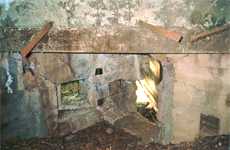 The line of the new combat-bunkers was placed in front of old strongpoints from the 1915-17 period. It started from the villages of Ogonki, Przytuly, Kruklanki, Milki, Wyszowate, Cierzpiety and finishing in Okartowo [Map]. Command bunkers determined the second line of defence on some sectors (Kruklanki, Wyszowate, Konopki Wielkie), with the old strongpoints becoming the third line. The Germans built approximately 180 structures of different types and in different locations. The basic types were shelters B1-1 and B1-1a (walls = 1 m thick reinforced concrete) with firing embrasure in frontal armoured plate 7P7 of 10cm thickness, intended for servicing 1 HMG (with 65 degrees sector fire). The Germans also built two-sectors shelters B1-5a and B1-7, shelters B1-3 with additional room of crew and with observational cupolas, shelters B1-2, B1-2a and B1-4/I for groups of infantry, and command-shelters B1-27. Structures B1-23 with three sectors cupolas for the HMG, along with special shelters for artillery-observers B1-28 with cupola and shelters for anti-tank guns & HMGs. Rare and expensive types were shelters with casemates of armour-plated 5P7 (an additional iron ceiling) "Deckenplatte" of types B1-9 and B1-13.
The line of the new combat-bunkers was placed in front of old strongpoints from the 1915-17 period. It started from the villages of Ogonki, Przytuly, Kruklanki, Milki, Wyszowate, Cierzpiety and finishing in Okartowo [Map]. Command bunkers determined the second line of defence on some sectors (Kruklanki, Wyszowate, Konopki Wielkie), with the old strongpoints becoming the third line. The Germans built approximately 180 structures of different types and in different locations. The basic types were shelters B1-1 and B1-1a (walls = 1 m thick reinforced concrete) with firing embrasure in frontal armoured plate 7P7 of 10cm thickness, intended for servicing 1 HMG (with 65 degrees sector fire). The Germans also built two-sectors shelters B1-5a and B1-7, shelters B1-3 with additional room of crew and with observational cupolas, shelters B1-2, B1-2a and B1-4/I for groups of infantry, and command-shelters B1-27. Structures B1-23 with three sectors cupolas for the HMG, along with special shelters for artillery-observers B1-28 with cupola and shelters for anti-tank guns & HMGs. Rare and expensive types were shelters with casemates of armour-plated 5P7 (an additional iron ceiling) "Deckenplatte" of types B1-9 and B1-13. 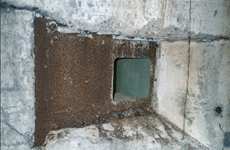 Shelter fire sectors were planned for straight or angled HMG-fire against attacking infantry. Essential feature shelters in GFR were planned for oblique fire from embrasures near entries. The Germans prepared the fire plane this way to better defend the back of structure. On open areas (Konopki - Miechy) all shelters (even simple B1-1!) provided for large iron plates for HMG in the rear of structures. All bunkers were completely gas-proof, including anti-gas-sluice and air filters, also a emergency exit, folding beds, stoves, reserves of food and water, tools and lighting. The most important equipment was the HMG type Maxim MG 08 (or new MG 34) on special gun carriages, placed on metal tables with boxes containing tools and accessories and a reserve of ammunition (40000 bullets).
Shelter fire sectors were planned for straight or angled HMG-fire against attacking infantry. Essential feature shelters in GFR were planned for oblique fire from embrasures near entries. The Germans prepared the fire plane this way to better defend the back of structure. On open areas (Konopki - Miechy) all shelters (even simple B1-1!) provided for large iron plates for HMG in the rear of structures. All bunkers were completely gas-proof, including anti-gas-sluice and air filters, also a emergency exit, folding beds, stoves, reserves of food and water, tools and lighting. The most important equipment was the HMG type Maxim MG 08 (or new MG 34) on special gun carriages, placed on metal tables with boxes containing tools and accessories and a reserve of ammunition (40000 bullets). From 1937 onward, building emphasis shifted to the westerly section of the GFR. The line of new combat-shelters was located at Wejdyki, Krzyzany, Martiany and on to Kronowo. In equal proportions, they built 40 shelters of one and two-sector HMG fire types (B1-1a or B1-5a & B1-7), with main roads being blocked with 4 (or 5) shelters for anti-tank guns and HMGs. In 1939 Germen also built 12 modern structures of series "100" (2m of reinforced concrete walls & ceilings called class "Bneu"). Four shelters (types Regelbau 112a & b versions) possessing six-sector cupolas for circuitous HMG-fire were constructed. Other types included the Regelbau 105b & d versions and 107b with casmates for HMGs. These possessed similar combat-equipment to shelters B1-type. The Germans improved the possibilities for observation, adding in the new shelters, additional rooms for observer (periscopes), separate rooms for crews and for air filters. Most bunkers built in versions "a" or "b" had small additional casements for HMGs near the rear entry fire sectors of new shelters. These were planned for flanking HMG-fire against attacking infantries. These objects could be useful in the chance of reversal of the front. Bunker Regelbau 105b in Martiany is the best-preserved and is a well-known structure of this of type. The schelters' schemes and armament.
In 1939 the Germans called as "Panzerwerke" (Pz.W. on use of propaganda!) the greatest military shelters for HMG or artillery observation with cupolas.
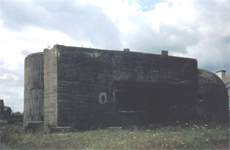 On all of the GFR, 7 Pz.W. structures and approximately 230 reinforced concrete objects of different types (95% for HMG) dating from 1936-39 were found. Including strongpoints from IWW there were approximately 500 shelters. This provided for huge fire saturation with the distances from shelter to shelter being about 80 m (the banks of lakes were not fortified practically until 1944). All of this building on the GFR supplemented the field fortifications, the wire entanglements and the moving anti-tank barriers on roads. To support the GFR Germany needed six divisions of infantry (four on the east and two on the west). This was difficult to realize as the forces were needed for the defence of Königsberg (forces including the Prussian Ist Corps). German High Command decided to create a skeleton of fortress-squads to prepare for the defences of all fortifications. They began training reservists of ages 35-45, well known later as Fortress-Brigade "Lötzen". These units consisted of two regiments of infantry (Landwehr) and one regiment of sappers with additional battalion. F-B "Lötzen" was situated in structures including the fortress at Boyen and at localities along the line of the fortifications.
On all of the GFR, 7 Pz.W. structures and approximately 230 reinforced concrete objects of different types (95% for HMG) dating from 1936-39 were found. Including strongpoints from IWW there were approximately 500 shelters. This provided for huge fire saturation with the distances from shelter to shelter being about 80 m (the banks of lakes were not fortified practically until 1944). All of this building on the GFR supplemented the field fortifications, the wire entanglements and the moving anti-tank barriers on roads. To support the GFR Germany needed six divisions of infantry (four on the east and two on the west). This was difficult to realize as the forces were needed for the defence of Königsberg (forces including the Prussian Ist Corps). German High Command decided to create a skeleton of fortress-squads to prepare for the defences of all fortifications. They began training reservists of ages 35-45, well known later as Fortress-Brigade "Lötzen". These units consisted of two regiments of infantry (Landwehr) and one regiment of sappers with additional battalion. F-B "Lötzen" was situated in structures including the fortress at Boyen and at localities along the line of the fortifications.On the eastern border of Prussia there appeared after the fall of Poland (IX-X 1939) a considerably more powerful enemy, the USSR. The GFR now included the new fortifications, intended help to organized new ad-hoc lines of defence. It began from a position along the rivers Narew & Pisa (Galindelinie), on the eastern front of the GFR, on the Mazurian Channel Position and on the northern flanks of the Lidzbark Triangle (Heilsberger Dreieck plus Dejme-line). The GFR included (in 1941) the IIIrd Reich Headquarters protection system. Inside the fortress was found the "Hochwald" HQ (Himmler, SS and Police). The GFR extended on the western belt of coverage (the line of field fortifications, checkpoints and anti-aircraft or anti-tank positions with 88mm guns) - Wegorzewo (Angerburg) - Przystan - Srokowo - Rozanka - Ketrzyn (Rastenburg) - Nakomiady - Krzyzany, around the "Wolfschanze" FHQ (Hitler & OKW), "Wendula" HQ (Lammers & IIIrd Reich Office), "Mauerwald-Anna" HQ (OKH) and "Westfalen" HQ (Ribbentrop & Foreign Office).
 In 1944 the Germans began "refreshing" the GFR when the Russian Red Army approached the borders of East Prussia. Gauleiter (chief NSDAP in EP) Erich Koch obtained Hitler's agreement in July 44 for the changes to the fortifications. Fortifications began with the strengthening of the so-called "Kochbunker" or "Ringstand". Wehrmacht soldiers sarcastically referred to these fortifications as "Kochtöpfe" (Koch's pot). Kochbunkers consisted from concrete 1,2m and sides of 10cm thickness. These contained exit openings leading to trenchs. The Kochbunker-version from the GFR was a simplified design for HMG type 34/42. Some Kochbunkers possessed observation or combat cupolas made of concrete. Using similar designs, they prepared "wells" for shelters for infrantry (grenadiers) or for simple ammunition wells. Kochbunkers were a flexible solution and given that they could be produced "en masse" and were transporable from place to place, they were widely developed and added to existing shelters. These structures enlarged the possibility of circuitous defence-fire. Portable defences were essential in the mobilization positions, including sectors on lake and river banks. Where other structures were not available, assembled Kochbunkers could be employed at small strongpoints using 3-4 structures, including arched concrete shelters for infantry. These measures ultimately came to be viewed as the small "Mazurian Atlanticwall" :) That is to say they occupied positions on northern bank of Sniardwy Lake (~15 km), consisting of field fortifications, anti-tank ditches and Kochbunkers. Near Kruklanki village (eastern front GFR) the Germans also built special combat casemates for anti-tank guns. The Wehrmacht began mining the foregrounds and the main roads. They also renewed barbed wire entanglements and anti-tank barriers. The Germans in these positions dug long anti-tank ditches, including ditches behind lakes (in case of freezing). New eastern belt of coverage of the GFR extended from south of the Pisz Position (Johannisburg-Stellung) to the lakes of Druglin, Mleczowka as well as the villages of Wydminy, Zywki, Jeziorowskie, Jakunowko and Budry. Here the defensive belt was renewed with old fortifications (from IWW) near Wegorapa River (Angerap-Stellung). The Germans prepared additional internal lines of defence. It included the old "Mazurian Lakes Position" (Masurische Seenstellung) supplemented in 1944 with field fortifications on section Gizycko - Mikolajki. A serious problem experienced by the German Command Group was lack of manpower and military forces, which would have allowed them to establish and to defend the
In 1944 the Germans began "refreshing" the GFR when the Russian Red Army approached the borders of East Prussia. Gauleiter (chief NSDAP in EP) Erich Koch obtained Hitler's agreement in July 44 for the changes to the fortifications. Fortifications began with the strengthening of the so-called "Kochbunker" or "Ringstand". Wehrmacht soldiers sarcastically referred to these fortifications as "Kochtöpfe" (Koch's pot). Kochbunkers consisted from concrete 1,2m and sides of 10cm thickness. These contained exit openings leading to trenchs. The Kochbunker-version from the GFR was a simplified design for HMG type 34/42. Some Kochbunkers possessed observation or combat cupolas made of concrete. Using similar designs, they prepared "wells" for shelters for infrantry (grenadiers) or for simple ammunition wells. Kochbunkers were a flexible solution and given that they could be produced "en masse" and were transporable from place to place, they were widely developed and added to existing shelters. These structures enlarged the possibility of circuitous defence-fire. Portable defences were essential in the mobilization positions, including sectors on lake and river banks. Where other structures were not available, assembled Kochbunkers could be employed at small strongpoints using 3-4 structures, including arched concrete shelters for infantry. These measures ultimately came to be viewed as the small "Mazurian Atlanticwall" :) That is to say they occupied positions on northern bank of Sniardwy Lake (~15 km), consisting of field fortifications, anti-tank ditches and Kochbunkers. Near Kruklanki village (eastern front GFR) the Germans also built special combat casemates for anti-tank guns. The Wehrmacht began mining the foregrounds and the main roads. They also renewed barbed wire entanglements and anti-tank barriers. The Germans in these positions dug long anti-tank ditches, including ditches behind lakes (in case of freezing). New eastern belt of coverage of the GFR extended from south of the Pisz Position (Johannisburg-Stellung) to the lakes of Druglin, Mleczowka as well as the villages of Wydminy, Zywki, Jeziorowskie, Jakunowko and Budry. Here the defensive belt was renewed with old fortifications (from IWW) near Wegorapa River (Angerap-Stellung). The Germans prepared additional internal lines of defence. It included the old "Mazurian Lakes Position" (Masurische Seenstellung) supplemented in 1944 with field fortifications on section Gizycko - Mikolajki. A serious problem experienced by the German Command Group was lack of manpower and military forces, which would have allowed them to establish and to defend the 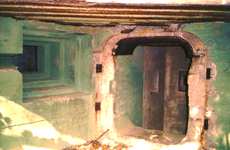 fortifications. As it was Guderian, (OKH chief), managed to establish only about 100 fortress battalions for the entire eastern front. Hitler at this time decided to utilization many these forces in Ardennes operation on the Belgian-German border. In place were the Volkssturm forces trained in September 1944 just for the defence of Eastern Prussia. There were still stationed squads of Group "Hauser", of the 23rd Infantry Division, and with the 605th Special Division (command & squads of artillery), with the 10th Cyclists Brigade, with the 20th Tank Division (exchanged in January to the 24th Tank Divison) and Grenadier Division "Brandenburg". These forces were devastated and decimated in successive battles and needed of urgent "re-organization". The Russians did not hesitate. In the region of Kruklanki - Wegorzewo - Gizycko (Borecka Forests) operated their special squad lead by Henryk Merecki (former partisans of the Polish undergound army - AK). His information and intelligence confirmed for the Russian Command, that frontal attack on region of the Great Mazurian Lakes would be aimless.
fortifications. As it was Guderian, (OKH chief), managed to establish only about 100 fortress battalions for the entire eastern front. Hitler at this time decided to utilization many these forces in Ardennes operation on the Belgian-German border. In place were the Volkssturm forces trained in September 1944 just for the defence of Eastern Prussia. There were still stationed squads of Group "Hauser", of the 23rd Infantry Division, and with the 605th Special Division (command & squads of artillery), with the 10th Cyclists Brigade, with the 20th Tank Division (exchanged in January to the 24th Tank Divison) and Grenadier Division "Brandenburg". These forces were devastated and decimated in successive battles and needed of urgent "re-organization". The Russians did not hesitate. In the region of Kruklanki - Wegorzewo - Gizycko (Borecka Forests) operated their special squad lead by Henryk Merecki (former partisans of the Polish undergound army - AK). His information and intelligence confirmed for the Russian Command, that frontal attack on region of the Great Mazurian Lakes would be aimless.
The southeast sector of the East Prussian front was the responsibility of the German 4th Army, commanded by the old Prussian, General Hossbach. His HQ was stationed at Zywki (later in "Wolfschanze" in Gierloz). He had many problems in the defence of of the GFR, including the problem of being able to supply only a single division in the harsh winter of 1944/45. All lakes, swamps, rivers and channels were covered with a 30-40cm sheet of ice. Over this ice even heavy Russian tanks were able to operate. All this diminished the value of GFR by at least half. Hitler and Guderian saw these problems otherwise. For them the GFR was the most powerful German eastern fortification. Based on this thinking, they planned for at least a three-months' defence, to be followed by counterattacks on the flanks of Russian armies. Hitler appeared to dream of a second Tannenberg (1914). He did not accept the information about the shattering superiority of Russian equipment and soldiers. In January of 1945 this "powerful roller", after only several days of the Russian offensive, became deeply outflanked from the south by the 2nd Belorussian Front, commanded by Marshal Rokossowski. In the neighbourhood of Gumbinnen (Gusiew) there occurred a series of bloody positional fights. Here the German 3rd Tank Army was slowly pushed back in the Königsberg direction
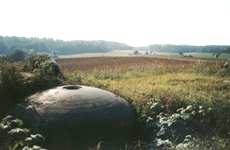 through the 3rd Belorussian Front. The German 4th Army found itself in a most difficult situation. The German commander by the 16th of January had planned a retreat from area of the Great Mazurian Lakes, even though he did not have the permission of the OKH. On the night of 21/22 January, General Hossbach assembled, in the "Wolfschanze", the Corps 4th Army Commanders and without agreement from Hitler or the OKH decided to abandon the fortified defensive position (also GFR) and to withdraw to the west. Hossbach gave orders to destroy all bridges, viaducts, railways and military headquarters. These decisions reached Berlin on the 25th of January and caused Hitler a great fury. One day earlier he had demanded that the defence of the GFR, after which when he received ominous the information from Königsberg. "The 4th Army escapes cowardly to the west. I will stay in place and I will defend East Prussia myself with my Volkssturm", was the message sent by Erich Koch. Guderian later wrote that it was with sorrow that he thought of the fall of the greatest and most modern of the German fortresses in the east. The derelict fortification GFR was passed on this day by advance parties of the Soviet 31st Army (3rd Belorussian Front), sweeping up into Gizycko and Wegorzewo despite an attempted defence by German police groups, firemen and Volsksturm. By the 27th of January 1945, all of the fortifications of the GFR had fallen into Russians hands.
through the 3rd Belorussian Front. The German 4th Army found itself in a most difficult situation. The German commander by the 16th of January had planned a retreat from area of the Great Mazurian Lakes, even though he did not have the permission of the OKH. On the night of 21/22 January, General Hossbach assembled, in the "Wolfschanze", the Corps 4th Army Commanders and without agreement from Hitler or the OKH decided to abandon the fortified defensive position (also GFR) and to withdraw to the west. Hossbach gave orders to destroy all bridges, viaducts, railways and military headquarters. These decisions reached Berlin on the 25th of January and caused Hitler a great fury. One day earlier he had demanded that the defence of the GFR, after which when he received ominous the information from Königsberg. "The 4th Army escapes cowardly to the west. I will stay in place and I will defend East Prussia myself with my Volkssturm", was the message sent by Erich Koch. Guderian later wrote that it was with sorrow that he thought of the fall of the greatest and most modern of the German fortresses in the east. The derelict fortification GFR was passed on this day by advance parties of the Soviet 31st Army (3rd Belorussian Front), sweeping up into Gizycko and Wegorzewo despite an attempted defence by German police groups, firemen and Volsksturm. By the 27th of January 1945, all of the fortifications of the GFR had fallen into Russians hands.
Instructions of Russians Engineers Staff in October 1944 had detailed the quick destruction of captured German fortifications, dams, anti-tank ditches and even of trenches. Russian sappers blew up shelters and "recovered" the steel from plates, cupolas etc. which was shipped back to Russia. They took any and all equipment. They detonated also German mines and misfires, removed from mine fields. The result today is that only a few well preserved shelters and structures are left. These have been left purposely for research purposes. In 1950 the Polish Command cataloged the remaining structures of the GFR (and other positions), for a planned mobilization points. After Poland agreed to the Warsaw Pact, it gave up the land fortifications of the old type. The Gizycko Fortified Region was finished as a military fortification.

